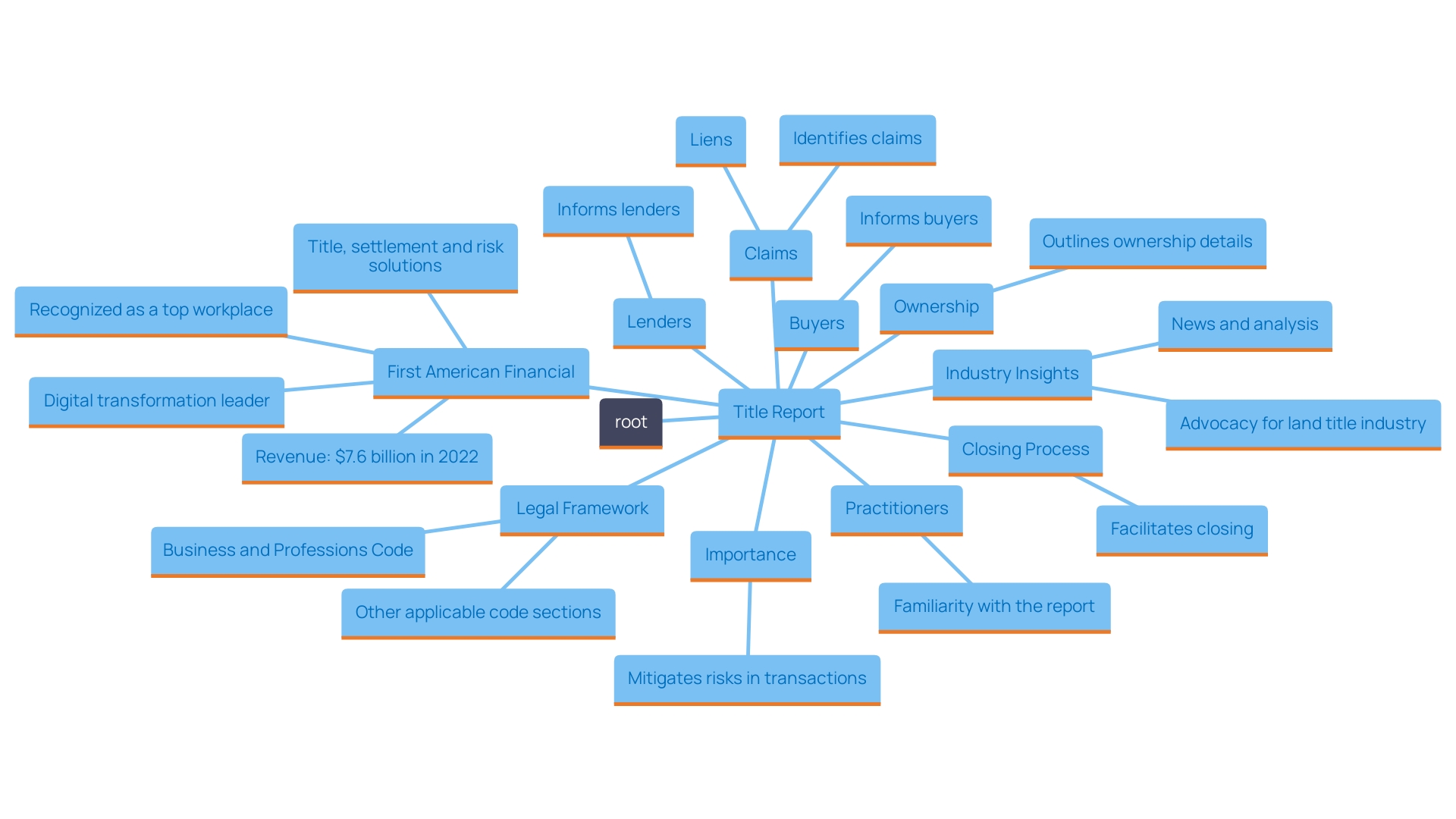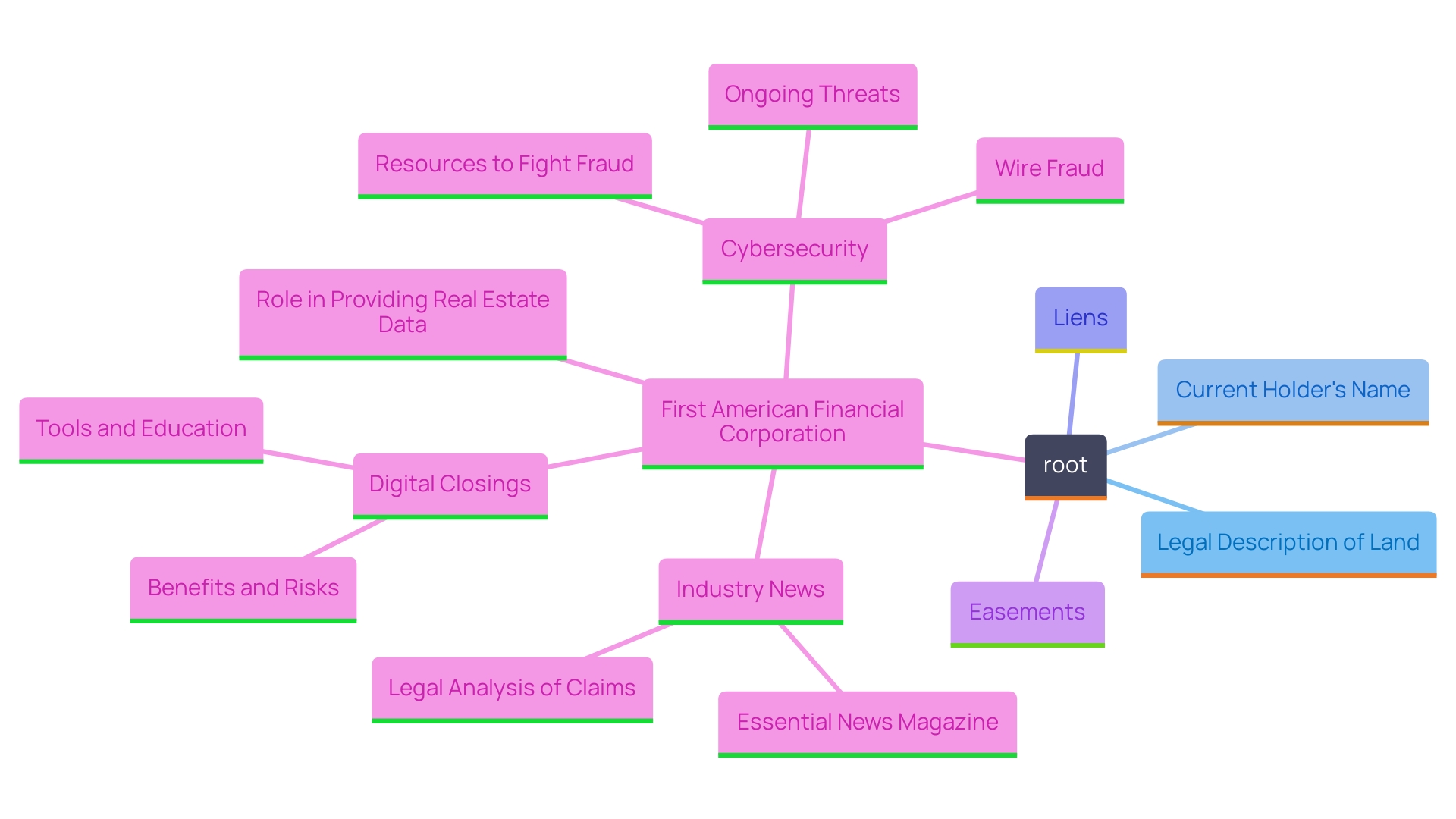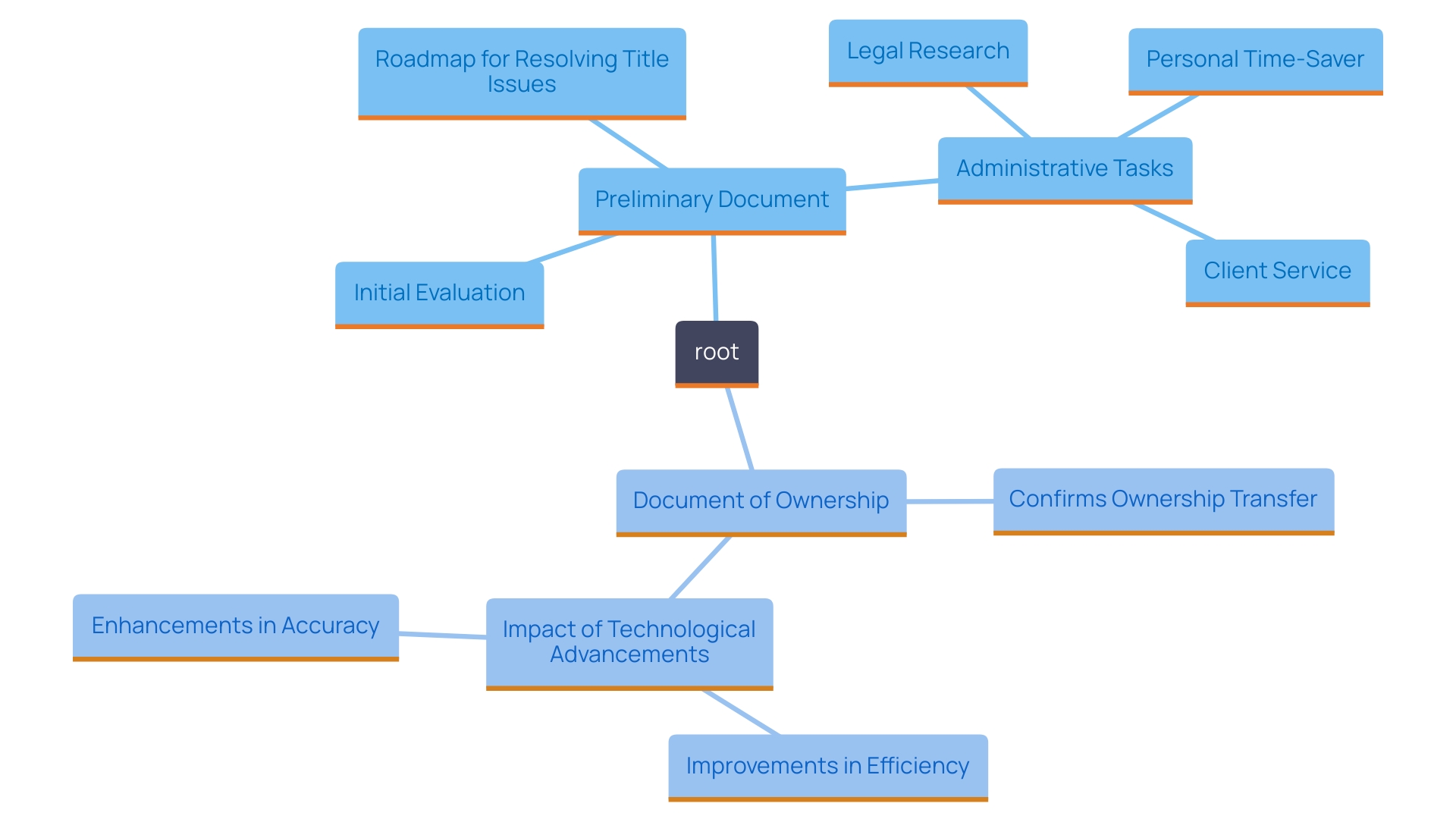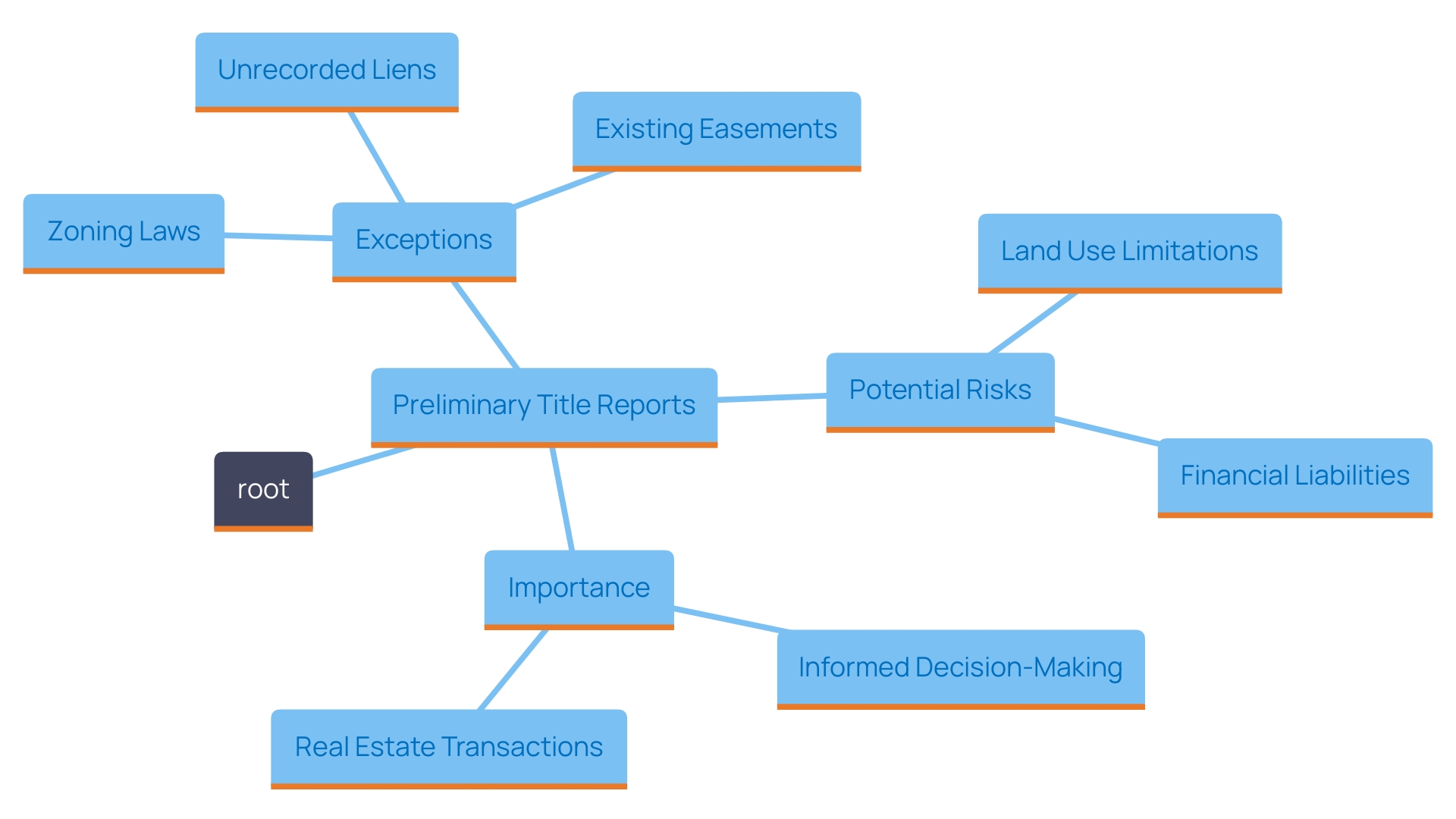Introduction
The Preliminary Title Report is an essential cornerstone in the realm of real estate transactions, offering a detailed examination of a property's title status. As a critical document prepared by title companies, it reveals current ownership and identifies any claims, liens, or encumbrances that could affect the property. This comprehensive overview not only aids potential buyers in making informed decisions but also assists lenders in evaluating financing risks.
Recognizing the importance of this report can significantly streamline the closing process and mitigate potential legal complications. By delving into its key components, understanding the distinctions between preliminary and final title reports, and exploring common exceptions, stakeholders can navigate the complexities of property transactions with greater confidence and clarity.
What is a Preliminary Title Report?
A Preliminary Title Report, often referred to as a ‘prelim,’ is an supplied by a title company that outlines the legal status of an asset's ownership. This report serves as an essential tool in real estate transactions, offering a comprehensive overview of current ownership as well as any claims, liens, or encumbrances that may impact the property. Typically generated following a thorough title search, the prelim highlights any potential issues that could affect the transfer of ownership.
The significance of the Preliminary Title Report cannot be overstated. It not only informs buyers about the legal standing of the property they are interested in but also helps lenders assess the risk associated with financing the purchase. For instance, if the report reveals any undisclosed liens or claims, this can significantly alter both the buyer's and lender's decisions. The report is structured to present information clearly and concisely, ensuring that all parties involved can easily interpret the findings.
Moreover, the report plays a critical role in facilitating the closing process. It allows for any necessary actions to be taken before the transaction is finalized, ensuring that all title issues are resolved promptly. As stated by industry specialists, possessing a clear comprehension of the Preliminary Document is essential for reducing risks and guaranteeing adherence to legal standards during the transaction process.

Key Components of a Preliminary Title Report
A Preliminary Title Report is a that outlines several essential components crucial for any real estate transaction. Among these components, the legal description of the land serves as the foundational identifier, detailing the exact boundaries and characteristics of the site in question. Along with this is the current holder's name, which determines who possesses the asset and is crucial for confirming ownership.
Furthermore, the report emphasizes any current liens or encumbrances that may impact the ownership rights. This information is vital as it can influence the buyer's decision-making process regarding the purchase. Along with liens, the report contains any easements, covenants, or restrictions, which may impose limitations or obligations on the land. Comprehending these elements is essential to evaluating the consequences of a real estate acquisition, as they directly connect to the transparency and safety of the ownership.
In a rapidly evolving market, where the landscape of title insurance and property transactions is continually changing, having access to comprehensive data and insights is indispensable. Entities like First American Financial Corporation play a pivotal role in this arena, offering innovative tools that facilitate access to real estate data, ensuring that stakeholders are well-informed about the implications of their transactions.

Preliminary Title Report vs. Title Report: Key Differences
Comprehending the differences between a Preliminary Document and a Document of Ownership is vital for managing real estate dealings successfully. A Preliminary Document functions as an initial evaluation, detailing the existing ownership situation and highlighting any possible concerns that may require resolution before finalizing. This proactive approach allows parties involved to address concerns early, minimizing the risk of complications during the final stages of a transaction.
In contrast, the document of ownership is created after the closing process has been finalized. It verifies the successful transfer of ownership and offers a clear guarantee concerning the condition of the ownership. Essentially, while the [Preliminary Title Report](https://blog.parseai.co/what-is-a-professional-title-understanding-its-importance-in-your-career) acts as a roadmap for addressing title-related issues, the Title Report serves as a conclusive document that solidifies the ownership transition.
This differentiation is particularly significant in an era marked by rapid technological advancements, including the integration of artificial intelligence in the sector. As highlighted by industry specialists, these technological changes improve operational efficiency, offering clearer insights into document statuses and ownership histories. With a growing emphasis on , the efficiency and accuracy of property investigation processes are expected to improve significantly, benefiting all stakeholders involved in real estate transactions.

Common Exceptions and Exclusions in Preliminary Title Reports
Preliminary Title Reports are in real estate transactions, providing an overview of the title's status and outlining specific exceptions and exclusions that the title insurance policy will not cover. These exceptions often include zoning laws, existing easements, and unrecorded liens, which are essential for buyers to understand. Understanding these details is crucial, as they emphasize potential risks that could affect land use or ownership.
For instance, a common exclusion might be zoning restrictions that could limit how a piece of land can be utilized. 'Current easements could grant third parties certain rights over the land, potentially affecting the owner's ability to develop or modify the area as they wish.'. Additionally, unrecorded liens may pose a financial risk, as they can arise from unpaid debts related to the asset that aren't documented in public records.
As highlighted by industry experts, "When you acquire a piece of real estate, you become the possessor of ownership.". A document provides the property owner rights to the property, including the right to possess, utilize, and transfer the property as desired This ownership is contingent upon having a clear understanding of these exceptions.
Understanding these nuances not only aids in informed decision-making but also helps in protecting buyers from future disputes or financial liabilities. Failure to recognize these exceptions could lead to significant challenges down the line, including the potential for unexpected financial loss due to unaddressed title defects.

Conclusion
The Preliminary Title Report serves as a fundamental document in real estate transactions, offering a detailed examination of a property's title status. Its importance is underscored by its role in revealing current ownership, as well as any claims, liens, or encumbrances that may impact the property. By providing a comprehensive overview, this report not only informs potential buyers but also assists lenders in assessing financing risks.
Understanding the key components and implications of the report is crucial for mitigating risks and ensuring a smoother closing process.
The distinctions between a Preliminary Title Report and a Title Report further highlight the report's significance. While the preliminary report acts as a proactive measure to identify potential issues before closing, the Title Report serves as a conclusive document that confirms the successful transfer of ownership. This differentiation is essential for stakeholders navigating the complexities of real estate transactions, especially in an era where technological advancements are reshaping the title industry.
Moreover, awareness of common exceptions and exclusions within the Preliminary Title Report is vital for informed decision-making. Recognizing zoning laws, existing easements, and unrecorded liens can prevent future disputes and financial liabilities. By grasping these nuances, buyers can protect themselves and ensure their rights to the property are secure.
Overall, a thorough understanding of the Preliminary Title Report is indispensable for anyone involved in real estate, ultimately leading to more successful and secure transactions.
Frequently Asked Questions
What is a Preliminary Title Report?
A Preliminary Title Report, often called a ‘prelim,’ is a document provided by a title company that outlines the legal status of a property's ownership, including any claims, liens, or encumbrances that might affect it.
Why is a Preliminary Title Report important?
The report is crucial for real estate transactions as it informs buyers about the property's legal standing and helps lenders assess financing risks. It highlights any undisclosed liens or claims that could influence decisions made by both buyers and lenders.
What information does a Preliminary Title Report include?
The report typically includes the legal description of the land, the current holder's name, any current liens or encumbrances, and easements, covenants, or restrictions that may affect ownership rights.
How does a Preliminary Title Report facilitate the closing process?
The report identifies any title issues that need resolution before the transaction is finalized, ensuring all parties can address concerns early and minimize risks.
What is the difference between a Preliminary Title Report and a Document of Ownership?
A Preliminary Title Report is an initial evaluation that highlights existing ownership and potential issues before closing, while a Document of Ownership is created after closing to verify the successful transfer of ownership.
What exceptions and exclusions might be noted in a Preliminary Title Report?
Exceptions typically include zoning laws, existing easements, and unrecorded liens. Understanding these details is essential, as they can present risks affecting land use or ownership.
How can failing to recognize exceptions in the Preliminary Title Report impact a buyer?
Not understanding these exceptions could lead to significant challenges, including unexpected financial losses due to unaddressed title defects or disputes regarding property rights.
Who plays a role in providing insights on Preliminary Title Reports?
Entities like First American Financial Corporation offer tools and data that help stakeholders understand the implications of their transactions in the real estate market.
How is technology improving the Preliminary Title Report process?
Advancements in technology, including artificial intelligence, enhance operational efficiency and provide clearer insights into document statuses and ownership histories, benefiting all parties involved in real estate transactions.




